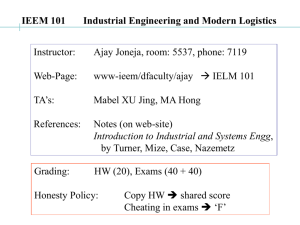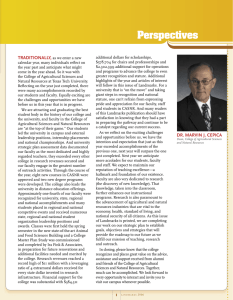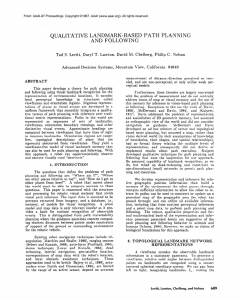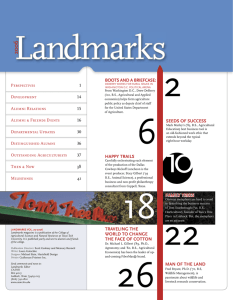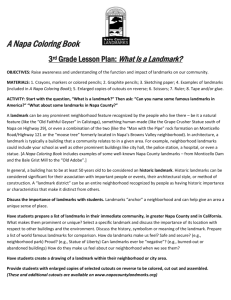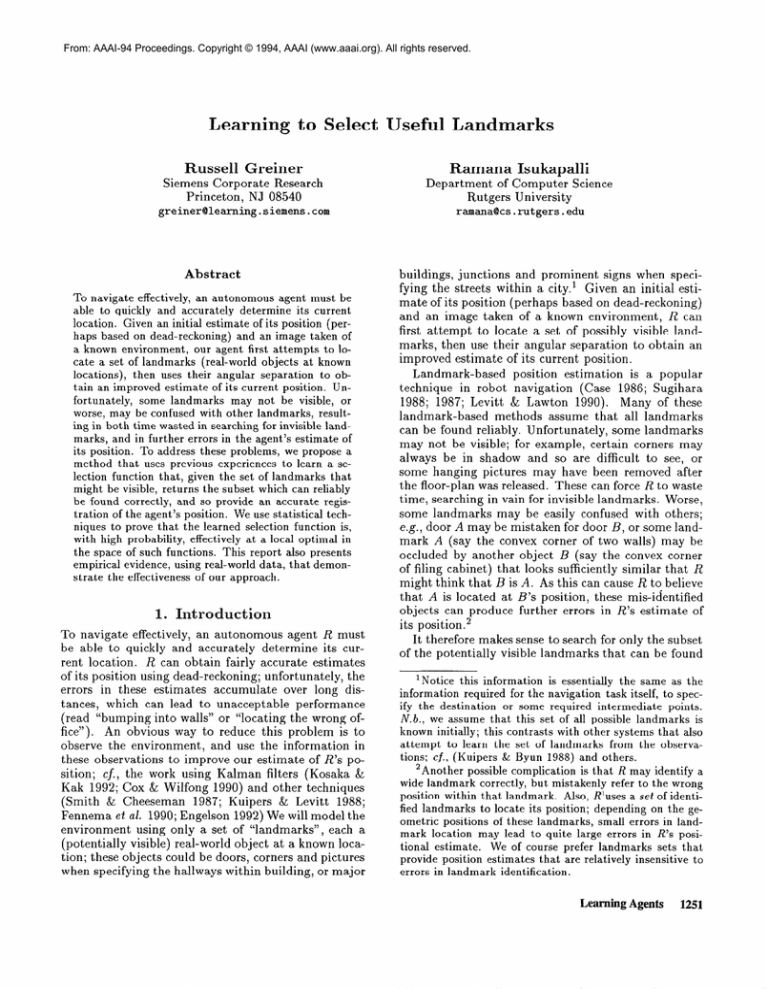
From: AAAI-94 Proceedings. Copyright © 1994, AAAI (www.aaai.org). All rights reserved.
Learning
Russell
to Select
Greiner
Siemens Corporate Research
Princeton, NJ 08540
greiner@learning.siemens.com
Abstract
To navigate effectively, an autonomous
agent must be
able to quickly and accurately
determine
its current
location.
Given an initial estimate of its position (perhaps based on dead-reckoning)
and an image taken of
a known environment,
our agent first attempts
to locate a set of landmarks
(real-world
objects at known
locations),
then uses their angular separation
to obtain an improved estimate of its current position. Unfortunately,
some landmarks
may not be visible, or
worse, may be confused with other landmarks,
resulting in both time wasted in searching for invisible landmarks, and in further errors in the agent’s estimate of
its position. To address these problems, we propose a
method that uses previous experiences
to learn a selection function that, given the set of landmarks
that
might be visible, returns the subset which can reliably
be found correctly,
and so provide an accurate
registration of the agent’s position. We use statistical
techniques to prove that the learned selection function is,
with high probability,
effectively at a local optimal in
the space of such functions.
This report also presents
empirical evidence, using real-world data, that demonstrate the effectiveness of our approach.
1. Introduction
To navigate effectively, an autonomous agent R must
be able to quickly and accurately determine its current location.
R can obtain fairly accurate estimates
of its position using dead-reckoning; unfortunately, the
errors in these estimates accumulate
over long distances, which can lead to unacceptable
performance
(read “bumping into walls” or “locating the wrong office”).
An obvious way to reduce this problem is to
observe the environment,
and use the information in
these observations to improve our estimate of R’s position; ~5, the work using Kalman filters (Kosaka &
Kak 1992; Cox & Wilfong 1990) and other techniques
(Smith & Cheeseman
1987; Kuipers & Levitt 1988;
Fennema et al. 1990; Engelson 1992) We will model the
environment using only a set of “landmarks”,
each a
(potentially visible) real-world object at a known location; these objects could be doors, corners and pictures
when specifying the hallways within building, or major
Useful
Landmarks
Ramana
Isukapalli
Department of Computer Science
Rutgers University
ramana@cs.rutgers.edu
buildings, junctions and prominent signs when specifying the streets within a city.’ Given an initial estimate of its position (perhaps based on dead-reckoning)
R can
and an image taken of a known environment,
first attempt to locate a set of possibly visible landmarks, then use their angular separation to obtain an
improved estimate of its current position.
Landmark-based
position estimation
is a popular
technique in robot navigation
(Case 1986; Sugihara
1988; 1987; Levitt & Lawton 1990).
Many of these
landmark-based
methods assume that all landmarks
can be found reliably. Unfortunately, some landmarks
may not be visible; for example, certain corners may
always be in shadow and so are difficult to see, or
some hanging pictures may have been removed after
the floor-plan was released. These can force R to waste
time, searching in vain for invisible landmarks. Worse,
some landmarks may be easily confused with others;
e.g., door A may be mistaken for door B, or some landmark A (say the convex corner of two walls) may be
occluded by another object B (say the convex corner
of filing cabinet) that looks sufficiently similar that R
might think that B is A. As this can cause R to believe
that A is located at B’s position, these mis-identified
objects can produce further errors in R’s estimate of
its position.2
It therefore makes sense to search for only the subset
of the potentially visible landmarks that can be found
is essentially the same as the
‘Notice
thi s i nformation
information
required for the navigation task itself, to specify the destination
or some required intermediate
points.
is
N.b., we assume that this set of all possible landmarks
known initially; this contrasts
with other systems that also
attempt
to learn the set of landmarks
from the observations; cf., (Kuipers & Byun 1988) and others.
2Another possible complication
is that R may identify a
wide landmark correctly, but mistakenly refer to the wrong
position within that landmark.
Also, R’uses a set of identified landmarks
to locate its position; depending on the geometric positions of these landmarks,
small errors in landmark location may lead to quite large errors in R’s positional estimate.
We of course prefer landmarks
sets that
provide position estimates that are relatively insensitive to
errors in landmark identification.
Learning Agents
1251
reliably, which are not confusable with others, etc. Unfortunately, it can be very difficult to determine this
good subset a priori, as (1) the landmarks that are
good for one set of R-positions can be bad for another;
(2) the decision to seek a landmark can depend on
many difficult-to-incorporate
factors, such as lighting
conditions and building shape; and (3) the reliability of
a landmark can also depend on unpredictable
events;
e.g., exactly where R happens to be when it observes
its environment,
how the building has changed after
the floor-plan was finalized, and whether objects (perhaps people) are moving around the area where R is
looking. These factors make it difficult, if not impossible, to designate the set of good landmarks ahead of
time.
This report presents a way around this problem:
Section 2 proposes a method that learns a good “selection function” that, given the set of landmarks that
may be visible, returns the subset which can usually
be found correctly. We also use statistical techniques
to prove that this learned selection function is, with
high probability, effectively at a local optimum in the
space of such functions. Section 3 then presents empirical results that demonstrate that this algorithm can
work effectively. We first close this section by presenting a more precise description of the performance task,
showing how R estimates its position:
Specification
of Performance
Task: At each point,
R will have an estimate 2 of its current position z and
a measure of the uncertainty (here the covariance matrix). R uses the LMs( x > algorithm to specify the
subset of the landmarks that may be visible from each
position x; we assume LMs ( jt > is essentially the same
as LMs ( x > . (I.e., we assume that R’s estimate of its
position is sufficient to specify a good approximation
of the set of possibly appropriate landmarks.)
R also
uses an algorithm Locate(
jE, 6, img, lms ) that,
given R’s estimate of its position jE and uncertainty &,
an image img taken at R’s current position and a set of
landmarks lms, returns a new estimated position (and
uncertainty) for R.
To instantiate these processes: In the current RATBOT system (Hancock & Judd 1993), the LMs process uses a comprehensive
“landmark-description”
of
the environment, which is a complete list of all of the
objects in that environment that could be visible, together with their respective positions.
This could be
based on the floor-plan
of a building,
which specifies the positions of the building’s doors, walls, wallhangings, etc.; or in another context, it could be a
map of the roads of a city, which specifies the locations
of the significant buildings, signs, and so forth. The
Locate(
?, c?, img, lms ) process first attempts to
find each landmark ai E lms within the image img; here
it uses ji and (3 to specify where in the image to look for
this Zi. It will find a subset of these landmarks, each at
some angle (relative to a reference landmark). Locate
then uses simple geometric reasoning to obtain a set of
1252
Robotics
new estimates of R’s position; perhaps one from each
set of three found landmarks (Hancock & Judd 1994))
or see (Gurvits & Betke 1994).
After removing the
obvious outliers, Locate
returns the centroid of the
remaining estimates as its positional-estimate
for R,
and the variance of these estimates as the measure of
uncertainty; see (Hancock & Judd 1993).
As our goal is an eficient way of locating R’s position, our implementation
uses an inexpensive way of
finding the set of landmarks based on simple tests on
the visual image; n. b., we are not using a general vision
system, which would attempt to actually identify specific objects and specify particular qualities from the
visual information.3
2. Function
for Selecting
Good
Landmarks
While many navigation systems would attempt to locate a/l of the landmarks that might be visible in an
image (i.e., the full set returned by LMs( 2 )), we argued above that it may be better to seek only a subset
of these landmarks:
By avoiding “problematic”
landmarks (e.g., ones that tend to be not visible, or confusable), R may be able to obtain an estimate of its
location more quickly, and moreover, possibly obtain
an estimate that is more accurate.
We therefore want to identify and ignore these bad
landmarks.
We motivate our approach by first presenting two false leads: One immediate suggestion is
to simply exclude the bad landmarks from the catalogue of all landmarks that LMs uses, meaning LMs( .>
will never return certain landmarks. One obvious complication is the complexity of determining which landmarks are bad, as this can depend on many factors, including the color of the landmark, the overall arrangement of the entire environment (which would specify
which landmarks could be occluded), the lighting conditions, etc. A more serious problem is the fact that a
landmark that is hard to see from one R position may
be easy to see, and perhaps invaluable, from another;
here, R should be able to use that landmark when registering its location from some positions, but not from
others.
We therefore decided to use, instead, a selection
function Se1 that filters out the bad landmarks from
the set of possibly
visible landmarks,
lms = LMs(
ii >:
Here, each selection function Se& returns a
subset Se& ( lms, 2, C? > = lmsi E lms; R then
uses this subset to compute its location,
returning
Locate( 2, 6, img, lms; ). We want to use a selection
function Seli such that Locate(
2, +, img, lmsi )
is reliably close to R’s true position, x. To make this
3Figure 3 shows, and describes, the actual “images” we
use. Also, this articles does not provide pseudo-code
for
either LMs or Locate,
as our learning algorithm
regards
these process as black-boxes.
more precise, let
Err( Se&, (x, ji,6, img) )
=
11x - Locate( 2, 6, img, Seli(LMs(ji),
be the error4 for the selection function
“situation” (x, 2, &, img), and let
AveErr( Seli )
2,6)
) ]I
Seli and any
=
Et x,g,s,img)
[Err(
Seh,
(x, %h
img)
>I
be the expected error, over the distribution
of situations (x, ?, &, img), where E. [.I is the expectation operator. Our goal is a selection function Sel+ that minimizes this expected value, over the set of possible selection functions.
The second false lead involves “engineering” this optimal selection function initially. One problem, as observed above, is the difficulty of determining “analytically” which landmarks are going to be problematic
for any single situation. Worse, recall that our goal is
to find the selection function that works best Ozler the
distribution
of situations; which depends on the distribution of R’s actual positions when the function is
called, the actual intensity of light sources, what other
objects have been moved where, etc. Unfortunately,
this distribution of situations is not known a priori.
We are therefore following a third (successful) apHere,
proach: of learning a good selection function.
we first specify a large (and we hope, comprehensive)
class of possible selection functions S = {Se&). Then,
given “labeled samples” - each consisting of R’s position and uncertainty estimates, the relevant landmarkset and image, and as the label, R’s actual position
- identify the selection function Se& which minimizes
AveErr ( Se& ).
Space of Selection F’unction: We define each selection function Sell, E S as a conjunction of its particular set of “heuristics” or “filters”; Filters(Selectk)
=
fm}, where each filter fi is a predicate that ac{fl'...'
cepts some landmarks and rejects others. Hence, the
Selectk(
lms,
2,
& > procedure will examine each
e E lms individually,
and reject it if any fi filter rejects it; see Figure 1.
While we can define a large set of such filters, this
report focuses on only two parameterized filters:
BadTypeK3 (.4!,2, &) :
TooSmallk,,k:,(!,
Reject e
if Type( !
if ]]Posn(e)
%, 6) : Reject !
and AngleWidth
) # Ka
- 211 > k1
2) < Jc:!
4As we are also c onsidering the efficiency of the overall
process, we will actually use the slightly more complicated
error function presented in Section 3 below.
This is also
why we did not address the landmark-selection
task using
robust analysis:
Under that approach,
our system would
first spend time and resources seeking each landmark,
and
would then decide whether to use each possible correspondence. As our approach, instead, specifies which landmarks
should be sought, we will gather less data, and so expend
fewer resources
Sel, ( lms: landmarks,
jc: pos ‘n, & : var. ) : landmarks
OK-LMs + {}
ForEach
e E lms
KeepLM + T
ForEach
f,
E Filters(
Sel,
>
] Then KeepLM c
F
If
[ f*(4
k (i) - Ignore
End (inner)
ForEach
If
[ KeepLM 3 T ]
Then OK-LMs +- OK-LMs + l
End (outer)
ForEach
Return(
OK-LMs >
End Select
Figure 1: Pseudocode
for Selj Selection
Function
where Type(e) re f ers to the type of the landmark !,
which can be “Door”,
“BlackStrip”,
etc.5
The parameter Ka specifies the subset of landmark-types
that
should be used. Using “Posn(!)”
to refer to e’s realworld coordinates and “AngleWidth(!,
2)” to refer to
the angle subtended by the landmark e, when viewed
from 2, TooSmallk,,k,(e,
?, 6) rejects the landmark 4?
if e is both too far away (greater than ICI meters) and
also too small (subtends an angle less than k2 degrees),
from R’s estimated position X.
Using these filters, S = {Selkl,k2,K3} is the set of
all selection functions, over a combinatorial
class of
settings of these three parameters. As stated above, we
want to find the best settings of these variables, which
minimize the expected error AveErr[ Selk, ,k2,~J 1.
Hill-Climbing
in Uncertain
Space: There are two
obvious complications
with our task of finding this optimal setting: First, as noted above, the error function
depends on the distribution of situations, which is not
known initially.
Secondly, even if we knew that information, it is still difficult to compute the optimal
parameter setting, as the space of options is large and
ill-structured (e.g., Ka is discrete, and there are subtle
non-linear effects as we alter kl and kz).
We use a standard hill-climbing
approach to address the second problem, based on a set of operators 7 = {ok} that each map one selection function to
another; i.e., for each s E S, Q(S) E S is another selection function. We use the obvious set of operators:
r: increments the value of ICI and 71 decrements ICI’s
value; hence T:(
and
7-;(
Sel5,
8,
Se15, 8,
{t1,t3,t7)
> =
{tl,t3,t7}
>
=
Sel4,
8,
Se16,
8,
{tl,t3,t7}
{t1,t3,t7je
Sim-
ilarly, T.$ and 72 respectively increment and decrement the ka value.
There are 9 different 7$ operator,
each of which “flips” the ith bit of Ii’s;
hence
Ti”(
$t
Sel5,
Sel5,
8,
{tl,t3,t7}
8,
{t1,t3,t7)
> =
>
Sel5,
8,
=
Sel5,
8,
{t3,t7)
and
{tl,t3,t7,t8}v
To address the first problem - viz., that the distribution is unknown -- we use a set of observed examples
5The current system contains nine different types: Miscellaneous,
Black-Strip,
Concave-Corner,
Convex-Corner,
Dark-Door,
Light-Door,
Picture,
FireExtinguisher
and
Support-between-Windows.
LearningAgents
1253
Sell : selectfn,
LEARNSF(
For
j
c
T7[se13
]
Take
n
u
If
l..oo
-
do
{ Tk((Sel,)
+
-
6: !l?+, 6: ?I?+ ) : select&i
}k
6 6 17-i
Select,
32
79
m( 5,
(Ul, . ..) un)
3 Sel’ E I[ Sel, ]
Sel,+l
Return
uzLI= (xI, &:,, &%,img;)
- ecU)[Sel’]
t
else [ Here, VSel’,
[Each
samples,
2
2
Sel’
BU)[Sel,]
- @(U)[Sel’]
<
$1
Sel,
End For
Figure 2: (Simplified)
Pseudocode
for
the relevant information:
=
=
kl,k2,K3
LEARNSF
Let
j& xu,EU
Err(
Se1k,,k2,&,
ui )
seen, to our confidence that .l?i”’ will be close to the
real mean pi = Eu j [ Err( Seli, uj ) ] = AveErr( Se& )
value. In particular, we need a function m(. . a) such
that, after m(e, S) samples, we can be at least 1-S confident that the empirical average a(u) will be within
E of the population
mean p; i.e., ]U] > m(~, S) +
PY[ Ifi@) - ~1 > E] 5 S. If we can assume that the
underlying distribution of error values is close to a normal distribution, then we can use
x
rnNorm(~9
where the z(p) = -&
6)
=
J[,
(
y-l
e-Gdz
5 2
Cl- -1)
2
function
computes
the pth quantile of the standard normal distribution
n/(0,1)
(Bickel & Doksum 1977).
The LEARNSF algorithm,
sketched in Figure 2,6
combines
the ideas of hill-climbing
with statistical
sampling:
Given an initial selection function Sell =
Selkl,k2,K3 E S, and the parameters E and 6, LEARNSF
will use a sequence of example situations {ui} to climb
from the initial Sell through successive neighboring
selection functions (Sell, Sel2, Sels, . . .) until reaching,
and returning,
a final Sel,.
With high probability, this Sel, is essentially a local optimum,
Moreover, LEARNSF requires relatively few samples for each
climb. To state this more precisely:
6We actually use much more efficient, but more complex, algorithm that, for example, decides whether to climb
to a new Sel,+l c Sel’ after observing each image, (rather
than a batch of n images); see (Greiner & Isukapalli 1994;
Greiner 1994).
Robotics
a
series
of selection
functions
Sell, Sel2, . . . , Se&,
such that
each Sel,+l = r3(SeZ,) for some r3 E I and, with probability at least 1 - 5,
I.
ficu)[ Err( Seh, ,k2,K3 > ]
be the empirical average error of the selection function Selk1,k2,K3 over the set of training samples U =
{ (xi, C, 6 imgJ }i, which we assume to be independent and identically distributed.
We then use some
statistical measure to relate the number of samples
1254
Figure 3: RATBOT’S
view (looking up at tree ornament), and “strip”, corresponding
to annulus in image
Theorem 1 (from (Greiner & Isukapalli 1994))
The LEARNSF(Se&, E, 6 ) process incrementally
produces
End LEARNSF
to estimate
p)
]
such that
&(U1[Sel,]
then Let
11 )
the expected
error of each selection
better than its predecessors
i.e.,
‘4’2 5 j 5 m: AveErr(Sel,-1)
<
2. the final
selection
function
SeL, is an ‘k-local optimum”
13 T E 7:
AveErr(
r(Se&)
function
is strictly
AveErr(Sel,);
and
(returned
by LEARNSF),
- i.e.,
) < AveErr(
Sel, ) - e .
given the statistical
assumption
that the underlying
distribution is essentially
normal.
Moreover,
LEARNSF will ter1, and will stay at any Sel, (beminate
with probability
fore either
terminating
or climbing
to a new Sel,+l)
for
a number
of samples
that is polynomial
in k, i, 171 and
X = max 7~7, SeZEs,u IErr(Se17 u, - Err(r(Sel),
u)l, which
is the largest
ing selection
diflerence
functions
3.
in error between
for any sample.
a pair
of neighbor-
cl
Empirical
To test the theoretical claims that a good selection
function can help an autonomous
agent to register
its position efficiently and accurately, and also that
LEARNSF can help find such good selection functions,
we implemented
various selection functions and the
LEARNSF learning algorithm, and incorporated
them
within the implemented autonomous agent, RATBOT,
described in (Hancock & Judd 1993). This section describes our empirical results.
We first took a set of 270 “pictures” at known locations within three halls of our building. Each of these
pictures is simply an array of 360 intensity values, each
corresponding to the intensity at a particular angle, in
a plane parallel to the floor; these are shown on righthand side of Figure 3. 7 We have also identified 157 different landmarks in these regions, each represented as
7These were obtained using a “NOMAD 200” robot with
a CCD camera mounted on top, pointing up at a spherical
mirror (which is actually a Christmas tree ornament);
see
left-hand side of Figure 3. We then extract from this image
a l-pixel annulus, which corresponds
to the light intensity
at a certain height; see right-hand
side of Figure 3.
2--l!J
560
---p-2
_ --Image
1 obo
Number
Figure 4: LEARNSF’S Hill-Climbs,
Selection Functions
15bo
for different
s
2obo
initial
simply an object of a specified type (one of the nine categories), located between a pair of coordinates (~1 9~1)
and (~2, ~2); where, once again, this (x, y) plane is parallel to the floor and goes through the center of the
bulb.
Each experiment used a particular initial selection
function, error function, values for E and S, way of estimating R’s position, and statistical assumption.
We
first describe one experiment in detail, then discuss a
battery of other experiments that systematically
vary
the experimental parameters.
Experiment#l
Specification:
LEARNSF began
with the Sell selection function shown in Figure 4.
This function rejects a landmark if either it is more
than 5 meters away from our estimated position and
also subtends an angle less than 0 degrees,’ or if
the landmark’s type is one of Concave-Corner,
Convex-Corner,
or Support-between-Windows
(these are
the second, third and ninth types, correspbnding
to
the bits that are 0 in the Sell row of Figure 4). We
used S = 0.05, meaning that we would be wiliing to
accept roughly 1 mistake in 20 runs. The E = 0.1 setting means that we do not care if the average error of
two selection functions differs by less than O.lm; as we
allowed errors as large as 4m, this corresponds to an
allowable tolerance of only 2.5%.
As our goal is to minimize both positional error and
computational
time, we use an error function that is
the weighted sum of the positional error (which is the
difference between the obtained estimated position and
the real position) and “#landmarks-to-pos’n-error
ratio” times the number of landmarks that were selected.
Here, we set the ratio to 0.01, to mean, in effect, that
each additional landmark “costs” O.Olm.
Finally, while we know that image imgi is taken at
location xi, it unrealistic to assume that RATBOT will
know that information;
in general, we assume that
RATBOT
will instead see an approximate
?jt,. We
8As nothing can subtend
this first clause is a no-op
landmark.
an angle strictly less than O”,
i.e., it will not reject any
a normally-distributed
random value with mean
and variance 0’. Here, we used cr = 0.3m. Recall
that the Locate function needs a value for ti to
strain its landmark-location
process; we also set
be CT.
zero
also
con& to
Experiment # 1 Results:
Given these settings,
LEARNSF
observed
62 labeled
samples
before
climbing
to the new selection
function
Sell.1
=
((5, 0); [llOlllIlO]),
which differs from Sell only by
not rejecting all Convex-Corners.g
It continued using this selection function for 40 additional samples,
before climbing to the Sell:2 = ((5, 2); [110111110])
selection function, which rejects landmarks that are
both more than 5m from R’s estimated position and
also less than 2’. It continued using this Sell:2 function
for another 700 samples before LEARNSF terminated,
declaring this selection function to be a “0.1-local optimum” - i.e., none of Sell:z’s neighbors has a utility
score that is more than E = 0.1 better than Sell,a. (We
found, in fact, that Sell,;! is actually a bona fide local
optimum, in that none of its neighbors is even as good
as it is.)
The solid line (labeled
“1”) in Figure 4 shows
LEARNSF’S performance
here. Each horizontal linesegment corresponds
to a particular selection function, where the line’s y-value indicates the “average
test error9, of its selection function, which was computed by running this selection function through all
270 images.l’ These horizontal lines are connected by
vertical lines whose x-value specify the sample numb&
when LEARNSF climbed.
Table 1 presents a more
detailed break-down of this data.
Other
Variants:
Our choice of Sell = ( (5, 0) ;
[lnolllllo])
was fairly arbitrary;
we also considered the four other reasonable starting selection functions shown in Figure 4.
Notice that Se12 =
((5, 10); [000000000])
rejects every landmark;
and
Se13 = ((5, 0); [111111111])
accepts every landmark.
Figure 4 also graphs the performance
of these functions. Notice that LEARNSF
finds improvements in all
five cases.
We also systematically
varied the other parameters:
trying values of E = 1.0, 0.2, 0.1, 0.05, 0.02,0.01,
0.005;
6
=
0.005,
0.01,
0.05,
0.1;
0
=
gse1i:, refers to the selection
climbs, when starting from Sel,.
function reached after
Hence, Sel,,o E Sel,.
j
“To avoid testing on the training data, we computed
this value using a new set of randomly-generated
positional
estimates,
{ jti = xz + ulC0”}, where again I(~)’ is a random
variable drawn from a O-mean a-variance
distribution.
LearningAgents
1255
0, 0.3, 0.5, 1.0; and the “#landmark-to-pos’n-error
ratio” of 0, 0.02, 0.05, 0.1, 0.2. (The 0 setting tells
LEARNSF
to consider only the accuracy of a landmark
set, and not the cost of finding those landmarks.)
We
also used LEARNSF HI, a variant of LEARNSF that replaces the ?nNo,-m (e) function with the weaker
function, which is based on Hoeffding’s inequality (Hoeffding 1963; Chernoff 1952), and so does not require
the assumption that the error values are normally distributed. All of these results are reported, in detail, in
(Greiner & Isukapalli 1994).
Summary
of Empirical Results: The first obvious
conclusion is that selection functions are useful; notice
in particular that the landmarks they returned enabled
R to obtain fairly good positional estimates - within
a few tenths of a meter. Notice also that the obvious
degenerate selection function
Sels which accepted all
landmarks, was not optimal; i.e., there were functions
that worked more effectively. Secondly, this LEARNSF
function works effectively, as it was able to climb to
successively better selection functions, in a wide variety of situations.
Not surprisingly, we found that the
most critical parameter was the initial selection function; the values of E, S, (T and even the “#landmark-topos’n-error ratio” had relatively little effect. We also
found that this LEARNSF Norm system seemed to work
more effectively than the version that did not require
the normality assumption, LEARNSFHI:
in almost all
instances, both systems climbed through essentially
the same selection functions, but LEARNSFN,,,
required many fewer samples - by a factor of between
10 and 100! (In the numerous different runs that used
S = 0.05, LEARNSF Norm climbed a total of 84 times
and terminated 24 times, and so had 84 + 24 = 108
opportunities
to make a mistake; it made a total of
only 3 mistakes all very minor.) Finally, LEARNSF'S
behavior was also (surprisingly)
insensitive to the accuracy of R’s estimated position, over a wide range of
errors; e.g. 9 even for non-trivial values of Iz - ?I.
4.
Conclusion
While there are many techniques that use observed
landmarks to identify an agent’s position they all depend on being able to effectively find an appropriate
set of landmarks, and will produce degraded or unacceptable information
if the landmarks are not found,
or mis-identified.
We can avoid this problem by using
only the subset of “good” landmarks. As it can be very
difficult to determine this subset a priori, we present
an algorithm,
LEARNSF,
that uses a set of training
samples to learn a function that selects the appropriate subset of the landmarks, which can then be used
robustly to determine our agent9s position.
We then
prove that this algorithm works effectively - both theoretically and empirically, based on real data obtained
using an implemented robot.
1256
Robotics
Acknowledgments
We gratefully acknowledge the help we received from
Thomas Hancock, Stephen Judd, Long-Ji Lin, Leonid
Gurvits and the other members of the RatBOT team.
References
Bickel, P. J., and Doksum,
K. A.
1977.
Mathematical Statistics:
Basic Ideas and Selected
Topics.
Oakland:
Holden-Day,
Inc.
Case, M. 1986.
robots.
In SPIE,
Single landmark
navigation
volume 727, 231-38.
by mobile
Chernoff, H. 1952. A measure of asymptotic
efficiency for
tests of a hypothesis
based on the sums of observations.
Annals
of Mathematical
Statistics
23:493-507.
Cox, I., and Wilfong,
Vehicles.
G.,
Springer-Verlag.
eds.
1990.
Autonomous
Robot
Engelson,
S. P. 1992. Active place recognition
using image signatures. In SPIE Symposium
on Intelligent
Robotic
Systems,
Sensor
Fusion
V, 393-404.
Fennema,
C.; Hanson,
A.; Riseman,
E.; Beveridge,
J.;
and Kumar, R. 1990. Model-directed
mobile robot navigation. IEEE
Transactions
on Systems,
Man and Cybernetics 20(6):1352-69.
Greiner, R., and Isukapalli,
useful landmarks.
Technical
R. 1994.
Learning to select
Report SCR-LS94-473.
Greiner, R. 1994. Probabilistic
applications.
Technical report,
hill-climbing:
SCR.
Theory
and
Gurvits, L., and Betke, M. 1994. Robot navigation
using
landmarks.
Technical Report SCR-94-TR-474,
SCR/MIT.
Hancock,
T., and Judd, S. 1993.
Ratbot:
Robot navigation using simple visual algorithms.
In 1993 IEEE Regional Conference
on Control
Systems.
Hancock,
T., and Judd, S.
1994.
Hallway
using simple visual correspondence
algorithms.
Report SCR-94-TR-479,
SCR.
navigation
Technical
1963.
Probability
inequalities
for sums
Hoeffding,
W.
of bounded random variables.
Journal
of the American
Statistical
Association
58(301):13-30.
Kosaka,
A., and Kak, A. C.
1992.
Fast vision-guided
mobile robot navigation using model-based
reasoning and
Computer
Vision,
Graphics,
prediction
of uncertainties.
56(3):271-329.
and Image Processing
Kuipers,
B. J., and Byun, Y.-T.
itative method for robot spatial
774-79.
Kuipers,
mapping
1988.
A robust, quallearning.
In AAAI-88,
Navigation
B. J., and Levitt, T. S. 1988.
in large-scale
space. AI Magazine
9(2):25-43.
Levitt, T. S., and Lawton, D. T.
gation for mobile robots. Artificial
and
1990. Qualitative
naviIntelligence
44:305-60.
Smith, R., and Cheeseman,
P. 1987. On the representation and estimation
of spatial uncertainty.
International
Journal
of Robotics
Research
5(4):56-68.
Sugihara, K. 1987. Location of a robot using sparse visual
information.
Robotics
Research:
The Fourth International
Symposium,
319-26.
MIT Press.
Sugihara, K. 1988. Some location problems for robot navigation using a single camera.
Computer
Vision,
Graphics
and Image Processing
42(1):112-29.



